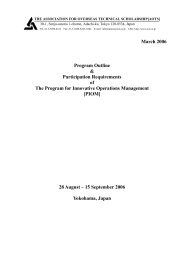Analysis of the Operation and Financial Condition of the Enterprise
Analysis of the Operation and Financial Condition of the Enterprise
Analysis of the Operation and Financial Condition of the Enterprise
You also want an ePaper? Increase the reach of your titles
YUMPU automatically turns print PDFs into web optimized ePapers that Google loves.
<strong>Analysis</strong> <strong>of</strong> <strong>the</strong> <strong>Operation</strong> <strong>and</strong> <strong>Financial</strong> <strong>Condition</strong> <strong>of</strong> <strong>the</strong> <strong>Enterprise</strong>happen. The shorter this period is <strong>the</strong> more liquid is each given element <strong>of</strong> assets. Liquiditymeasures is <strong>the</strong> capacity <strong>of</strong> an enterprise to execute any payments <strong>and</strong> debt settlementswith creditors on a due date <strong>and</strong> in a certain amount. Liquidity is <strong>the</strong> key issue in <strong>the</strong>financial performance <strong>of</strong> an enterprise. The objective <strong>of</strong> <strong>the</strong> enterprise performance is toensure a constant, sufficient amount <strong>of</strong> <strong>the</strong> means <strong>of</strong> payment.Liquidity can be discussed from two points <strong>of</strong> view: From <strong>the</strong> point <strong>of</strong> view <strong>of</strong> dissolution <strong>of</strong> an enterprise, i.e., it should be specified whatmeans <strong>of</strong> payment would be <strong>the</strong>re at <strong>the</strong> disposal <strong>of</strong> an enterprise that could beallocated to meet <strong>the</strong> liabilities if an enterprise should undergo <strong>the</strong> process <strong>of</strong>dissolution due to insolvency or insufficient pr<strong>of</strong>itability. In order to find an answer tothis question <strong>the</strong> following information is required: on revenues that an enterprise couldacquire in <strong>the</strong> case <strong>of</strong> potential dissolution from <strong>the</strong> disposal <strong>of</strong> its property; <strong>the</strong> amount<strong>of</strong> preferential claims; <strong>the</strong> amount <strong>of</strong> a secured loan. Such information cannot be foundin <strong>the</strong> financial statements. This means that in <strong>the</strong> process <strong>of</strong> <strong>the</strong> annual report analysisliquidity in this aspect is not discussed. Liquidity is discussed in this way when <strong>the</strong>crediting arrangements are being established. From <strong>the</strong> aspect <strong>of</strong> <strong>the</strong> enterprise as a going concern; <strong>the</strong> probability that an enterprisecould become insolvent <strong>and</strong> could be forced into liquidation should be assessed.However, as <strong>the</strong> information found in <strong>the</strong> financial statements is based on <strong>the</strong> goingconcern principle, while analysing <strong>the</strong> balance sheet liquidity may be discussed onlyfrom this perspective. Information regarding liquidity is crucial as insolvency causes<strong>the</strong> threat <strong>of</strong> winding up <strong>the</strong> operations <strong>of</strong> an enterprise. Businessmen <strong>and</strong> analysts areinterested in <strong>the</strong> future liquidity figures <strong>and</strong> not those <strong>of</strong> <strong>the</strong> past. The anticipatedliquidity figures cannot be found out merely according to <strong>the</strong> data <strong>of</strong> accountingreports, but <strong>the</strong> data from <strong>the</strong> finance planning must be extensively used. A pr<strong>of</strong>itableenterprise is usually also solvent as it has access to sufficient credit resources.There are several disadvantages <strong>of</strong> <strong>the</strong> liquidity measures: <strong>the</strong>y are static – presented ratios are calculated based on <strong>the</strong> balance sheet datawhich describe <strong>the</strong> property status as <strong>of</strong> a certain date, <strong>the</strong>refore, to assess <strong>the</strong>changes in <strong>the</strong> ratio it is recommended to view <strong>the</strong>m in dynamics or compare with<strong>the</strong> ratio level <strong>of</strong> o<strong>the</strong>r similar enterprises; <strong>the</strong>y provide little information for <strong>the</strong> forecasting <strong>of</strong> future revenues <strong>and</strong> expenses,however, this is exactly <strong>the</strong> main current solvency task; incomplete accounting for enterprise liabilities (if <strong>the</strong>re is a choice to present a loanin <strong>the</strong> balance sheet with or without <strong>the</strong> interest). Classification <strong>of</strong> assets depends on changes in <strong>the</strong> economic conditions. It isnot fixed, but varying (unstable deliveries <strong>and</strong> high inflation). Peculiarities <strong>of</strong> <strong>the</strong> areas <strong>of</strong> enterprise activities <strong>and</strong> <strong>the</strong> working capital.This ratio can be increased in two ways: By increasing <strong>the</strong> amount <strong>of</strong> individual items <strong>of</strong> current assets; By reducing <strong>the</strong> amount <strong>of</strong> short-term liabilities.68
















